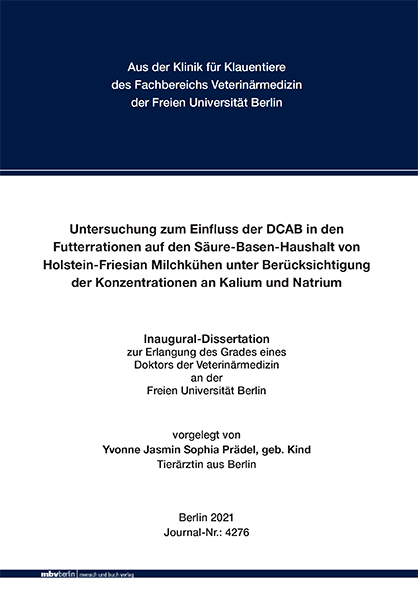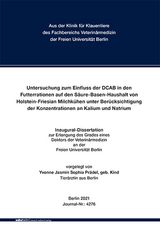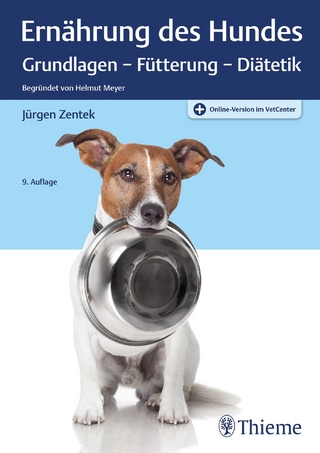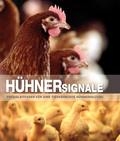Untersuchung zum Einfluss der DCAB in den Futterrationen auf den Säure-Basen-Haushalt von Holstein-Friesian Milchkühen unter Berücksichtigung der Konzentrationen an Kalium und Natrium
Seiten
2021
|
1. Aufl.
Mensch & Buch (Verlag)
978-3-96729-127-8 (ISBN)
Mensch & Buch (Verlag)
978-3-96729-127-8 (ISBN)
- Keine Verlagsinformationen verfügbar
- Artikel merken
Das Konzept der Dietary Cation Anion Balance (DCAB) wird vorrangig in der Geburtsvorbereitungsphase bei Milchkühen genutzt. Diese Arbeit befasst sich mit den Auswirkungen der DCAB auf den Säure-Basen-Haushalt (SBH) bei laktierenden Milchkühen. Außerdem wurde in der Literaturrecherche der Einfluss verschiedener Konzentrationen der beiden Hauptkationen der DCAB (Natrium und Kalium) auf die Leistung von Milchkühen beleuchtet.
Für die Untersuchungen wurden 78 laktierende Holstein-Friesian Milchkühe (100-200 Tage in Milch) über Futterwiegetröge gefüttert. So konnten in drei Durchgängen verschiedene DCABVariationen den Tieren vorgelegt und deren Einfluss auf den SBH mittels Blut-, Harn- und Pansensaftproben gemessen werden. Vor der jeweiligen Untersuchung erhielten alle Tiere die betriebsübliche Ration (+80 bis +220 mEq/kg Trockenmasse (TM)). Anschließend wurden die Tiere zufällig, aber ausgewogen nach der Laktationsnummer, in zwei Gruppen eingeteilt. Die Kontrollgruppe bekam weiterhin die betriebsübliche Ration, während der Untersuchungsgruppe ein DCAB-regulierendes Ergänzungsfuttermittel zusätzlich unter die Ration gemischt wurde. In Untersuchung 1 erhielt die Untersuchungsgruppe SoyChlor®, ein anionisches Ergänzungsfuttermittel mit hohem Anteil an Chlorid (Kontrolle: +200 bis +220 mEq/kg TM/ Untersuchung: +55 bis +73 mEq/kg TM). In Untersuchung 2 wurde der Untersuchungsgruppe zusätzlich BICAR®Z (Natriumhydrogenkarbonat) als natriumhaltiges kationisches Ergänzungsfuttermittel gefüttert (Kontrolle: +80 mEq/kg TM / Untersuchung: +221 mEq/kg TM). Die dritte Untersuchung unterteilt sich in drei Abschnitte: In Abschnitt 1 bekam die Untersuchungsgruppe CS-Dihydrat QS – ein anionisches Calciumsulfatgemisch – gefüttert (Kontrolle: +143 mEq/kg TM/ Untersuchung: -6 mEq/kg TM), in Abschnitt 2 wurden die Rationen getauscht (Kontrollgruppe erhielt nun das Mineral – Kontrolle: +1 mEq/kg TM / Untersuchung: +145 mEq/kg TM) und in Abschnitt 3 wurde der supplementierten Gruppe BICAR®Z als Puffer zugeführt, um die DCAB auf den Wert der Untersuchungsgruppe anzuheben (Kontrolle: +77 mEq/kg TM/ Untersuchung: +150 mEq/kg TM). Die Rationen wurden alle 2-3 Wochen analytisch geprüft. Über den Zeitraum der Untersuchungen wurden zu Beginn und Ende die Lebendmasse, die Rückenfettdicke, der Body Condition Score und Blutparameter (pH, pCO2, HCO3, BE, Natrium, Kalium) gemessen. Alle 1-2 Wochen erfolgte eine Harnprobenentnahme (pH, Netto-Säure-Basen-Ausscheidung (NSBA), Na, K, Ca, Mg, P, Cl, Crea) und an drei Zeitpunkten (Beginn, Mitte und Ende) der Untersuchung wurden Pansensaftproben (pH, Methylenblautest (MBT), Sedimentaktivitätszeit (SAT), Sensorik) entnommen. Die Lebendmasse, die Rückenfettdicke und der Body Condition Score zeigten in allen drei Durchgängen keine signifikanten Veränderungen durch die DCAB und bestätigen somit einheitliche Gruppen.
Es zeigten sich bei azidogen wirkender DCAB (Anreicherung mit Chlorid, Schwefel) signifikante Effekte auf die Blut- (pH, HCO3, BE) und Pansensaftparameter (pH) des SBH, welche quantitativ aber nur gering ausgeprägt waren. Bei erhöhter DCAB konnten im Blut und Pansensaft keine signifikanten Effekte festgestellt werden. Es konnten keine Auswirkungen auf die Werte des Pansensaftscorings (MBT, SAT, Sensorik) festgestellt werden. Die Kaliumkonzentration im Blut zeigt nur in Abschnitt 3.2 einen Anstieg bei niedriger DCAB, was auf eine azidotische Belastung hindeuten kann. Auf die Harnparameter pH, NSBA und Calcium hat die DCAB einen deutlichen Einfluss. NSBA und pH sinken bei niedriger DCAB und die Calciumausscheidung steigt. Bei erhöhter DCAB steigen der pH und die NSBA während die Calciumkonzentration sinkt. Die Magnesiumkonzentration zeigt in den ersten beiden Untersuchungen einen ähnlichen Verlauf wie die Calciumkonzentration. In Untersuchung 3 kann kein Einfluss gefunden werden. Die Konzentrationen von Natrium und Chlorid sind vom jeweiligen Gehalt im Futter abhängig. Die Kalium- und Phosphorkonzentration im Harn werden nicht durch die DCAB beeinflusst. Die Creatininkonzentration über den Harn sinkt bei hoher DCAB und steigt bei niedriger DCAB.
Schlussfolgernd kann festgehalten werden, dass es bei laktierenden Milchkühen einen signifkanten Einfluss der DCAB auf den SBH gibt. Aus diesem Grund sollte die Ration der Milchkühe nicht nur in der Vorbereitung auf die Geburt zur Beurteilung der Wirkung der Gebärpareseprophylaxe überprüft werden, sondern auch in den Rationen aller Laktationsstadien. Dies sei vor dem Hintergrund gesagt, dass v. a. azidogene Rationen (Untersuchung 1 und 2) zu Auswirkungen im SBH (Blut, Harn und Pansensaft) führen, während eine alkalogene Ration weniger starke Einflüsse hat. Als Mittel der Wahl zur Beurteilung der Wirkung der DCAB auf den SBH ist die Harnprobe gegenüber der Blutprobe im Stall am besten geeignet, da sie in beiden Richtungen (azidotisch und alkalogen) wertvolle Hinweise und schnellere Ergebnisse liefert. The influence of DCAB in feed rations on the acid-base balance in Holstein-Friesian dairy cows, taking into consideration concentrations of potassium and sodium
The concept of the Dietary Cation Anion Balance (DCAB) is mainly used in the feed rations of dry cows. The thesis investigates the impact of DCAB on the acid-base-status of lactating cows. Futhermore, the influence of different concentrations of sodium and potassium as the main cations of the DCAB on the performance of lactating cows was examined through literature research.
For this study, 78 lactating cows (lactating for 100-200 days) were fed by special feeding troughs, which were able to record the dry matter intake. Different variations of DCAB were tested in three trial periods by the measurement of blood-, urine- and rumen parameters. At the start of each trial period the animals were fed with the usual feed rations (+80 to +220 mEq/kg dry matter (DM)). Afterwards the cows were randomly divided into two groups (the control group and investigation group), balanced by the number of lactations. The control group received the control feed ration and the investigation group received the control feed ration which had been supplemented with an anionic salt. During the first trial period, SoyChlor® - with high fraction of chloride (control: +200 to +220 mEq/kg DM/ investigation: +55 to +73 mEq/kg DM) - was used as the supplement. During the second trial period, BICAR®Z (sodium hydrogen carbonate) was added to the control ration (control: 80 mEq/kg DM/ investigation: 221 mEq/kg DM). The third trial period was divided into three segments. In the first segment CS-Dihydrat QS (anionic salt with calcium sulphate) was supplemented to the control ration (control: +143 mEq/kg DM/ investigation: -6 mEq/kg DM). During the second segment, feed rations were switched between the two groups (control: +1 mEq/kg DM/ investigation: +145 mEq/kg DM). In the third segment, BICAR®Z was additionally fed to the supplemented group from the second segment, in order to align the DCAB level (control: +77 mEq/kg DM/investigation: +150 mEq/kg DM).
At the beginning and at the end of each trial period, the body weight, back fat thickness, the overall body condition score and the blood parameters (pH, pCO2, HCO3, BE, Na, K) were measured. The TMR (Total Mixed Rations) were checked and analysed every two or three weeks. The urine parameters (pH, Netto Acid Base Excretion (NABE), Na, K, Ca, Mg, P, Cl, Crea) were measured every week or every other week. Rumen fluid samples (for methylene blue test, determinant of pH, sediment activity time and sensory properties) were taken at the beginning, in the middle and at the end of each trial period. There were no significant differences in the parameters in body weight, back fat thickness and the overall body condition score in all of the trial periods. Thus the uniformity of the groups was guaranteed.
It was shown that especially the lower acidogenic DCAB (with chloride or sulphur) had an effect on the blood (pH, HCO3, BE) and rumen parameters (pH) of the acid-base-balance. With increased amounts of DCAB, no significant effects were detected, neither in the blood nor in the rumen fluid of the cows. There was no significant impact on the rumen parameters`methylene blue test, sediment activity time and sensory properties. The concentration of potassium in the blood increased - with decreased DCAB only in the second segment of the third trial. This indicates an acidosis, evoked by the low level of DCAB. DCAB has a clear influence on the urine parameters pH, NABE and the concentration of calcium. With decreased DCAB, both pH and NABE decreased and the calcium concentration increased. With increased DCAB, the pH and NABE increased and the calcium concentration decreased. During the 1st and 2nd trial periods, the magnesium concentration showed a similar level as the calcium concentration. This effect could not be observed in 3rd trial period: there was no signifikant impact on the magnesium concentration. The excretion of sodium and chloride depends on the content of the respective ion in the feed ration. There were no significant effects on the urine concentration of potassium or phosphate by the DCAB. The excretion of urine creatinine decreased when the DCAB was high and increased when the DCAB was low.
In conclusion, an explicit impact of the DCAB on the acid-base-status of lactating cows was determined. For this reason, DCAB is recommended to also be used – in addition to the feeding of dry cows – in the analysis and calculation of feed rations for lactating dairy cows in all stages of lactation. This is especially important, because the greatest effect on the acid-base-balance in blood, urine and rumen is caused by acidogenic DCAB (1st and 2nd trial periods) whereas alkalogenic feed rations do not have such a great influence. The DCAB of customary feed rations varies from +80 to +220 mEq/kg dry matter. The lower value is not recommended any more for lactating dairy cows. For verification measurement in the barn, urine sampling is the most suitable method to obtain valuable information in both directions (about alkalosis or acidosis) as well as to obtain prompt results.
Für die Untersuchungen wurden 78 laktierende Holstein-Friesian Milchkühe (100-200 Tage in Milch) über Futterwiegetröge gefüttert. So konnten in drei Durchgängen verschiedene DCABVariationen den Tieren vorgelegt und deren Einfluss auf den SBH mittels Blut-, Harn- und Pansensaftproben gemessen werden. Vor der jeweiligen Untersuchung erhielten alle Tiere die betriebsübliche Ration (+80 bis +220 mEq/kg Trockenmasse (TM)). Anschließend wurden die Tiere zufällig, aber ausgewogen nach der Laktationsnummer, in zwei Gruppen eingeteilt. Die Kontrollgruppe bekam weiterhin die betriebsübliche Ration, während der Untersuchungsgruppe ein DCAB-regulierendes Ergänzungsfuttermittel zusätzlich unter die Ration gemischt wurde. In Untersuchung 1 erhielt die Untersuchungsgruppe SoyChlor®, ein anionisches Ergänzungsfuttermittel mit hohem Anteil an Chlorid (Kontrolle: +200 bis +220 mEq/kg TM/ Untersuchung: +55 bis +73 mEq/kg TM). In Untersuchung 2 wurde der Untersuchungsgruppe zusätzlich BICAR®Z (Natriumhydrogenkarbonat) als natriumhaltiges kationisches Ergänzungsfuttermittel gefüttert (Kontrolle: +80 mEq/kg TM / Untersuchung: +221 mEq/kg TM). Die dritte Untersuchung unterteilt sich in drei Abschnitte: In Abschnitt 1 bekam die Untersuchungsgruppe CS-Dihydrat QS – ein anionisches Calciumsulfatgemisch – gefüttert (Kontrolle: +143 mEq/kg TM/ Untersuchung: -6 mEq/kg TM), in Abschnitt 2 wurden die Rationen getauscht (Kontrollgruppe erhielt nun das Mineral – Kontrolle: +1 mEq/kg TM / Untersuchung: +145 mEq/kg TM) und in Abschnitt 3 wurde der supplementierten Gruppe BICAR®Z als Puffer zugeführt, um die DCAB auf den Wert der Untersuchungsgruppe anzuheben (Kontrolle: +77 mEq/kg TM/ Untersuchung: +150 mEq/kg TM). Die Rationen wurden alle 2-3 Wochen analytisch geprüft. Über den Zeitraum der Untersuchungen wurden zu Beginn und Ende die Lebendmasse, die Rückenfettdicke, der Body Condition Score und Blutparameter (pH, pCO2, HCO3, BE, Natrium, Kalium) gemessen. Alle 1-2 Wochen erfolgte eine Harnprobenentnahme (pH, Netto-Säure-Basen-Ausscheidung (NSBA), Na, K, Ca, Mg, P, Cl, Crea) und an drei Zeitpunkten (Beginn, Mitte und Ende) der Untersuchung wurden Pansensaftproben (pH, Methylenblautest (MBT), Sedimentaktivitätszeit (SAT), Sensorik) entnommen. Die Lebendmasse, die Rückenfettdicke und der Body Condition Score zeigten in allen drei Durchgängen keine signifikanten Veränderungen durch die DCAB und bestätigen somit einheitliche Gruppen.
Es zeigten sich bei azidogen wirkender DCAB (Anreicherung mit Chlorid, Schwefel) signifikante Effekte auf die Blut- (pH, HCO3, BE) und Pansensaftparameter (pH) des SBH, welche quantitativ aber nur gering ausgeprägt waren. Bei erhöhter DCAB konnten im Blut und Pansensaft keine signifikanten Effekte festgestellt werden. Es konnten keine Auswirkungen auf die Werte des Pansensaftscorings (MBT, SAT, Sensorik) festgestellt werden. Die Kaliumkonzentration im Blut zeigt nur in Abschnitt 3.2 einen Anstieg bei niedriger DCAB, was auf eine azidotische Belastung hindeuten kann. Auf die Harnparameter pH, NSBA und Calcium hat die DCAB einen deutlichen Einfluss. NSBA und pH sinken bei niedriger DCAB und die Calciumausscheidung steigt. Bei erhöhter DCAB steigen der pH und die NSBA während die Calciumkonzentration sinkt. Die Magnesiumkonzentration zeigt in den ersten beiden Untersuchungen einen ähnlichen Verlauf wie die Calciumkonzentration. In Untersuchung 3 kann kein Einfluss gefunden werden. Die Konzentrationen von Natrium und Chlorid sind vom jeweiligen Gehalt im Futter abhängig. Die Kalium- und Phosphorkonzentration im Harn werden nicht durch die DCAB beeinflusst. Die Creatininkonzentration über den Harn sinkt bei hoher DCAB und steigt bei niedriger DCAB.
Schlussfolgernd kann festgehalten werden, dass es bei laktierenden Milchkühen einen signifkanten Einfluss der DCAB auf den SBH gibt. Aus diesem Grund sollte die Ration der Milchkühe nicht nur in der Vorbereitung auf die Geburt zur Beurteilung der Wirkung der Gebärpareseprophylaxe überprüft werden, sondern auch in den Rationen aller Laktationsstadien. Dies sei vor dem Hintergrund gesagt, dass v. a. azidogene Rationen (Untersuchung 1 und 2) zu Auswirkungen im SBH (Blut, Harn und Pansensaft) führen, während eine alkalogene Ration weniger starke Einflüsse hat. Als Mittel der Wahl zur Beurteilung der Wirkung der DCAB auf den SBH ist die Harnprobe gegenüber der Blutprobe im Stall am besten geeignet, da sie in beiden Richtungen (azidotisch und alkalogen) wertvolle Hinweise und schnellere Ergebnisse liefert. The influence of DCAB in feed rations on the acid-base balance in Holstein-Friesian dairy cows, taking into consideration concentrations of potassium and sodium
The concept of the Dietary Cation Anion Balance (DCAB) is mainly used in the feed rations of dry cows. The thesis investigates the impact of DCAB on the acid-base-status of lactating cows. Futhermore, the influence of different concentrations of sodium and potassium as the main cations of the DCAB on the performance of lactating cows was examined through literature research.
For this study, 78 lactating cows (lactating for 100-200 days) were fed by special feeding troughs, which were able to record the dry matter intake. Different variations of DCAB were tested in three trial periods by the measurement of blood-, urine- and rumen parameters. At the start of each trial period the animals were fed with the usual feed rations (+80 to +220 mEq/kg dry matter (DM)). Afterwards the cows were randomly divided into two groups (the control group and investigation group), balanced by the number of lactations. The control group received the control feed ration and the investigation group received the control feed ration which had been supplemented with an anionic salt. During the first trial period, SoyChlor® - with high fraction of chloride (control: +200 to +220 mEq/kg DM/ investigation: +55 to +73 mEq/kg DM) - was used as the supplement. During the second trial period, BICAR®Z (sodium hydrogen carbonate) was added to the control ration (control: 80 mEq/kg DM/ investigation: 221 mEq/kg DM). The third trial period was divided into three segments. In the first segment CS-Dihydrat QS (anionic salt with calcium sulphate) was supplemented to the control ration (control: +143 mEq/kg DM/ investigation: -6 mEq/kg DM). During the second segment, feed rations were switched between the two groups (control: +1 mEq/kg DM/ investigation: +145 mEq/kg DM). In the third segment, BICAR®Z was additionally fed to the supplemented group from the second segment, in order to align the DCAB level (control: +77 mEq/kg DM/investigation: +150 mEq/kg DM).
At the beginning and at the end of each trial period, the body weight, back fat thickness, the overall body condition score and the blood parameters (pH, pCO2, HCO3, BE, Na, K) were measured. The TMR (Total Mixed Rations) were checked and analysed every two or three weeks. The urine parameters (pH, Netto Acid Base Excretion (NABE), Na, K, Ca, Mg, P, Cl, Crea) were measured every week or every other week. Rumen fluid samples (for methylene blue test, determinant of pH, sediment activity time and sensory properties) were taken at the beginning, in the middle and at the end of each trial period. There were no significant differences in the parameters in body weight, back fat thickness and the overall body condition score in all of the trial periods. Thus the uniformity of the groups was guaranteed.
It was shown that especially the lower acidogenic DCAB (with chloride or sulphur) had an effect on the blood (pH, HCO3, BE) and rumen parameters (pH) of the acid-base-balance. With increased amounts of DCAB, no significant effects were detected, neither in the blood nor in the rumen fluid of the cows. There was no significant impact on the rumen parameters`methylene blue test, sediment activity time and sensory properties. The concentration of potassium in the blood increased - with decreased DCAB only in the second segment of the third trial. This indicates an acidosis, evoked by the low level of DCAB. DCAB has a clear influence on the urine parameters pH, NABE and the concentration of calcium. With decreased DCAB, both pH and NABE decreased and the calcium concentration increased. With increased DCAB, the pH and NABE increased and the calcium concentration decreased. During the 1st and 2nd trial periods, the magnesium concentration showed a similar level as the calcium concentration. This effect could not be observed in 3rd trial period: there was no signifikant impact on the magnesium concentration. The excretion of sodium and chloride depends on the content of the respective ion in the feed ration. There were no significant effects on the urine concentration of potassium or phosphate by the DCAB. The excretion of urine creatinine decreased when the DCAB was high and increased when the DCAB was low.
In conclusion, an explicit impact of the DCAB on the acid-base-status of lactating cows was determined. For this reason, DCAB is recommended to also be used – in addition to the feeding of dry cows – in the analysis and calculation of feed rations for lactating dairy cows in all stages of lactation. This is especially important, because the greatest effect on the acid-base-balance in blood, urine and rumen is caused by acidogenic DCAB (1st and 2nd trial periods) whereas alkalogenic feed rations do not have such a great influence. The DCAB of customary feed rations varies from +80 to +220 mEq/kg dry matter. The lower value is not recommended any more for lactating dairy cows. For verification measurement in the barn, urine sampling is the most suitable method to obtain valuable information in both directions (about alkalosis or acidosis) as well as to obtain prompt results.
| Erscheinungsdatum | 24.09.2021 |
|---|---|
| Verlagsort | Berlin |
| Sprache | deutsch |
| Maße | 148 x 210 mm |
| Gewicht | 450 g |
| Themenwelt | Veterinärmedizin ► Allgemein ► Tierernährung / Tierhaltung / Tierzucht |
| Veterinärmedizin ► Großtier | |
| Schlagworte | Acids • Animal nutrition • Ausgewogenheit • balances • Basen • Bases • Blood • Blut • cattle feeding • Chlorid • Chloride • dairy cow • DCAB • Holstein-Friesian • Holstein-Friesian cows • Holstein-Friesian Kühe • Kalium • Milchkuh • Milchkühe • Natrium • Pansensaft • Potassium • rumen fluid • Säuren • sodium • Sulfate • Tierernährung • Urin • Urine • Viehfütterung |
| ISBN-10 | 3-96729-127-8 / 3967291278 |
| ISBN-13 | 978-3-96729-127-8 / 9783967291278 |
| Zustand | Neuware |
| Informationen gemäß Produktsicherheitsverordnung (GPSR) | |
| Haben Sie eine Frage zum Produkt? |
Mehr entdecken
aus dem Bereich
aus dem Bereich
Grundlagen - Fütterung - Diätetik Begründet von Helmut Meyer
Buch (2022)
Thieme (Verlag)
91,00 €
Praxisleitfaden für eine tiergerechte Hühnerhaltung
Buch | Softcover (2023)
Landwirtschaftsverlag Münster
44,80 €




